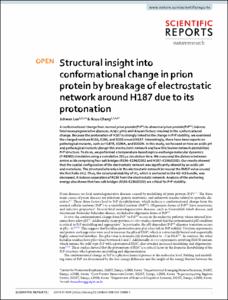Department of Brain Sciences
Theoretical and Computational Biophysics Laboratory
1. Journal Articles
Full metadata record
| DC Field | Value | Language |
|---|---|---|
| dc.contributor.author | Lee, Ju Hwan | ko |
| dc.contributor.author | Chang, Iksoo | ko |
| dc.date.accessioned | 2020-02-27T08:40:54Z | - |
| dc.date.available | 2020-02-27T08:40:54Z | - |
| dc.date.created | 2019-12-27 | - |
| dc.date.issued | 2019-12 | - |
| dc.identifier.citation | Scientific Reports, v.9, no.1 | - |
| dc.identifier.issn | 2045-2322 | - |
| dc.identifier.uri | http://hdl.handle.net/20.500.11750/11378 | - |
| dc.description.abstract | A conformational change from normal prion protein(PrPC) to abnormal prion protein(PrPSC) induces fatal neurodegenerative diseases. Acidic pH is well-known factors involved in the conformational change. Because the protonation of H187 is strongly linked to the change in PrP stability, we examined the charged residues R156, E196, and D202 around H187. Interestingly, there have been reports on pathological mutants, such as H187R, E196A, and D202N. In this study, we focused on how an acidic pH and pathological mutants disrupt this electrostatic network and how this broken network destabilizes PrP structure. To do so, we performed a temperature-based replica-exchange molecular dynamics (T-REMD) simulation using a cumulative 252 μs simulation time. We measured the distance between amino acids comprising four salt bridges (R156–E196/D202 and H187–E196/D202). Our results showed that the spatial configuration of the electrostatic network was significantly altered by an acidic pH and mutations. The structural alteration in the electrostatic network increased the RMSF value around the first helix (H1). Thus, the structural stability of H1, which is anchored to the H2–H3 bundle, was decreased. It induces separation of R156 from the electrostatic network. Analysis of the anchoring energy also shows that two salt-bridges (R156-E196/D202) are critical for PrP stability. © 2019, The Author(s). | - |
| dc.language | English | - |
| dc.publisher | Nature Research | - |
| dc.title | Structural insight into conformational change in prion protein by breakage of electrostatic network around H187 due to its protonation | - |
| dc.type | Article | - |
| dc.identifier.doi | 10.1038/s41598-019-55808-1 | - |
| dc.identifier.wosid | 000503211700001 | - |
| dc.identifier.scopusid | 2-s2.0-85076605328 | - |
| dc.type.local | Article(Overseas) | - |
| dc.type.rims | ART | - |
| dc.description.journalClass | 1 | - |
| dc.identifier.citationVolume | 9 | - |
| dc.identifier.citationNumber | 1 | - |
| dc.identifier.citationTitle | Scientific Reports | - |
| dc.type.journalArticle | Article | - |
| dc.description.isOpenAccess | Y | - |
| dc.subject.keywordPlus | SYNCHRONIZATION | - |
| dc.subject.keywordPlus | OLIGOMERIZATION | - |
| dc.subject.keywordPlus | MOLECULAR-DYNAMICS | - |
| dc.subject.keywordPlus | HYDROPHOBIC CORE | - |
| dc.subject.keywordPlus | NMR STRUCTURE | - |
| dc.subject.keywordPlus | SALT BRIDGES | - |
| dc.subject.keywordPlus | MUTATION | - |
| dc.subject.keywordPlus | CONVERSION | - |
| dc.subject.keywordPlus | STABILITY | - |
| dc.subject.keywordPlus | PH | - |
| dc.contributor.affiliatedAuthor | Chang, Iksoo | - |
- Files in This Item:
-
 기타 데이터 / 6.58 MB / Adobe PDF
download
기타 데이터 / 6.58 MB / Adobe PDF
download
- Appears in Collections:
- Department of Brain Sciences Theoretical and Computational Biophysics Laboratory 1. Journal Articles



